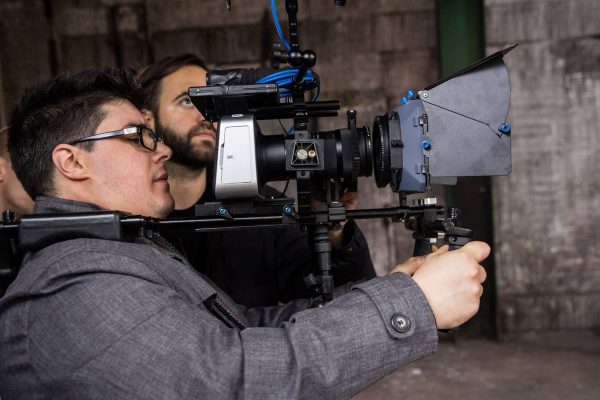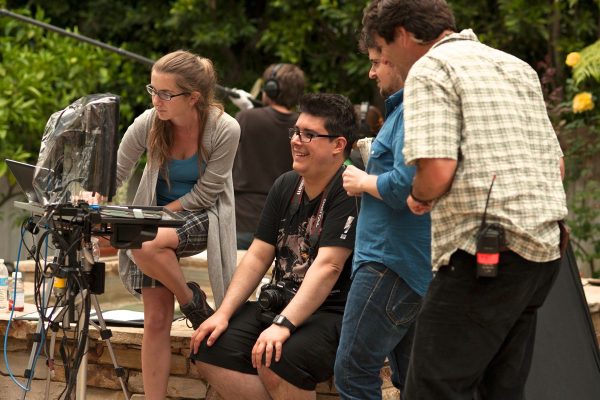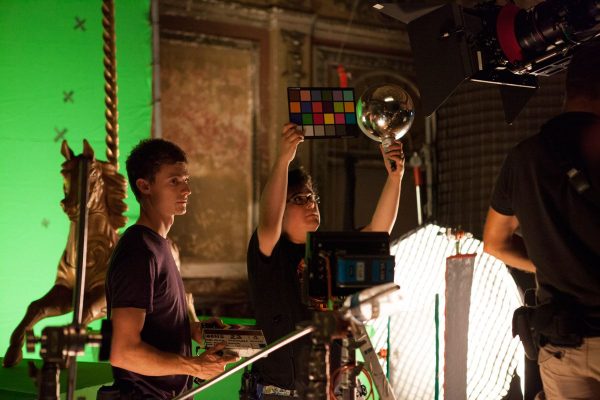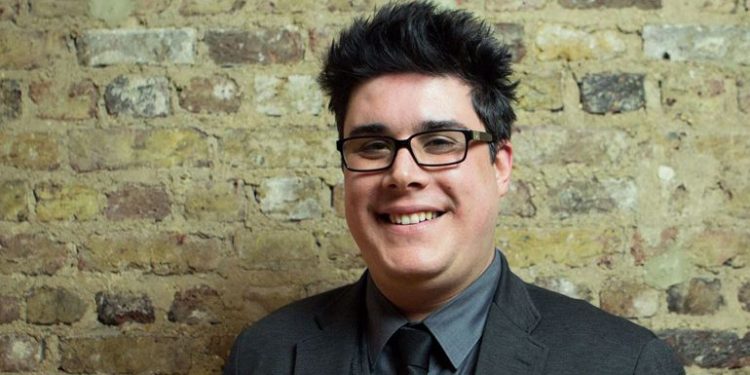We’re excited to share with you our latest fxphd Prof. profile, this time with NUKE229 Professor Hugo Guerra – an experienced vfx artist, supervisor, freelancer and trainer who has worked at several studios, including The Mill where he was recently the visual effects supervisor and 2d lead on the BBC Music ‘God Only Knows’ promo. Here we find out how Hugo got started in VFX, become a NUKE power-user and going from fxphd student to fxphd Prof.
fxphd: Can you give us a brief rundown of how you got into visual effects, and what you’re up to now?
Guerra: It all started back in 1996. I am originally from Portugal, and always had a huge passion for cinema and the arts, so I went to University and did a Masters in Fine Arts for five years. During my time there I started making a lot of video art, so I learned Premiere and After Effects to make my own films. Soon after, I managed to direct a few music videos, TV spots and corporate films, nothing glamorous, but it was a great start in the industry.

After a few years in Portugal with my own company TimeCode, I decided to move. Portugal’s film and VFX industry is very small and I wanted to spread my wings. I sent my showreel to dozens of places all over Europe and got hired over Skype in one of the first companies that contacted me: Animech AB. I was hired to be an After Effects compositor and Final Cut operator in this “up and coming” award winning company. After 1 year, I became their visual effects art director, handling almost all the visual effects of the company, going on-set, compositing, look development, you name it, I did it.
This was a great place for experimentation for me to develop great CGI techniques to make projects for many companies like GE Electric, ABB, Radi, Merk, Ericsson, etc. I worked there for 4 years. Soon after that I had a great calling to move to the UK, by then, London, was flourishing as a capital of visual effects in Europe, so I moved in 2009, first to work as a VFX supervisor on-set on a children’s TV Show called “Mi High” and after I worked as a freelance senior NUKE artist in many companies including The Mill, Nexus, Jelly Fish, Atomic Arts, The Foundry, Escape Studios, NFTS, among others. Today I’m working as an independent VFX supervisor, under my own company, splitting my time between working in visual effects, consulting companies in pipeline and creative processes and, of course, lecturing and teaching in many events and schools all over the world.
I just finished a great short film starring Martin Starr directed by Peter Livolsi called “Leonard in Slow Motion”, it’s been doing great in all the film festival circuits and will be online by the end of the year. Currently I joined forces with Peter once again, and his directing partner Martin Dix, to make a new short film, but I’m afraid I can’t talk about that one just yet.

fxphd: What was your first contact with fxphd?
Guerra: Like most visual effects artists, I used fxphd to learn new techniques of visual effects and advance my knowledge as an artist. fxphd has always been, for me, the best online school out there, mostly because of its commitment to use very skilled real production people as teachers. It’s fundamental to learn from the best of the industry and fxphd provides this service for a very competitive pricing.
It’s, of course, a great honour, after all these years of watching, to actually take part of the process and create courses for fxphd. I started last year working in the first online course for The Foundry’s conform and pipeline tool HIERO and this year I have the pleasure of making the first tutorial for the brand new application NUKE Studio. It’s been a blast.

fxphd: Can you talk about what you think fxphd is able to offer students, such as interaction with the profs?
Guerra: fxphd gives you unprecedented access to some of the best minds in visual effects today. With a very active forum built with a huge community of students, artist, professionals and inspirational people from all over the world it is a great place to share and learn from the best. I personally think that, if you need to improve, introduce visual effects into a facility or learn as an individual, it’s a “no brainer” to use fxphd – they have courses for all levels and skills inside the visual effects Industry.
fxphd: What do you hope students will get out of your NUKE Studio course at fxphd?
Guerra: The course is designed to take you through all the procedures and pipelines we use in the industry to run a organised production. We go over everything from shot management, updating timelines, distributing work across artists and of course the new Timeline, soft effects and compositing environment of Studio. I am hoping that students, after they do my course, become fully capable of handling a project from start to finish inside NUKE Studio, like they would have done in the past inside an application like Flame.

fxphd: The BBC God Only Knows project seems like a dream job – what was the most challenging part of the work?
Guerra: I have to say, it was the most challenging but rewarding project of my career. I think the most difficult part was the work I did on-set. Because of the complexity of artist schedules we had to film pretty much every single one of them separately, and that took a huge amount of planning, meetings and a lot of improvising. Also very challenging was the integration of all the green screen plates into the orchestra environments filmed months apart. It was a collection of stitching, merging, and “Frankensteining” shots together, sometimes with 4, 5 and 6 plates merged seamlessly. It was a great project and a great pleasure to work with creative director Sam Walker from Karmarama and director Francois Rousselet. Read fxguide’s full coverage of God Only Knows.
– Watch The Mill’s making of for God Only Knows.
fxphd: You’ve always had a strong affinity with NUKE – what was it about the software that got you hooked?
Guerra: During my time in Sweden, at Animech, I had a great opportunity to use this, back then, brand new application from The Foundry. Being a great fan of Digital Domain, I knew about NUKE since 2005, and as soon as it was commercially released by The Foundry I started using it in production.
Coming from After Effects and then Shake, NUKE seemed, at the time, like the natural transition. Mostly doing full CG at Animech, the linear workflows, robust 3D projections and specially the multi-pass EXR’s where the most advanced workflows back then. Today I think NUKE is, by far, the most used application for advanced visual effects for film, and, I believe, with HIERO and now NUKE Studio it will take over visual effects for commercials too.

fxphd: What was involved in being the head of NUKE at The Mill, in terms of daily work but also interaction with The Foundry and also other artists?
Guerra: Working at The Mill as a VFX supervisor and head of the NUKE department was a fantastic experience. I built an entire NUKE and HIERO pipeline there catering to a commercial fast paced environment of short term productions with small teams. We had also a great connection with The Foundry and, during HIERO’s alpha development, we had weekly meetings about the software.
The Foundry always has been great with its strong connection with artists and facilities. In the department, at some point, we were around 30 people and the key for its success was, without a shadow of a doubt, the strong bond and communication between all the artists in that department. While I was the Head of NUKE, me and my team were responsible for hundreds of commercials, short films, promos, etc, including projects like the Bodycount Game Trailer, the Rainbow Six game Trailer, the VES nominated Audi ‘Hummingbird’, Adidas “BatlePack”, Cif “Slepping Beauty” IKEA ‘Gnomes’, Call of Duty ‘Ghosts’ in-game cinematics and many others. My last project at The Mill was the BBC Music promo “God Only Knows”.

fxphd: What would be some of your main pieces of advice for people getting into compositing, what things should they look out for in finishing a comp?
Guerra: That is a hard question, but maybe I can give two pieces of advice. First one, for me it’s all about photography, it’s the most important core skill to have to develop a great compositing eye. It’s all about learning about lighting, colour, shadows, lens distortion, refractions, diffusions, etc. Nothing like taking a picture to learn how to make one.
I currently teach a VFX Photography 1 week crash course in Sweden’s Campus i12 Visual Effects school and it’s been a huge success, not only because it makes students go out, leave the tablets and monitors behind, but it really develops creativity and collaboration. I often make them work in cinemagraph exercises in groups and the results are very high quality projects.
Second advice, I have always believed that more important then the software skills are the creative skills, so besides photography I also recommend using multiple applications and be as flexible as possible. This will make you not only more appealing to a company, but also will make you think outside the box and master improvisation in visual effects, making you a more complete artist. It’s all about the merging or art and technique, don’t forget that. So don’t get “stuck”in one application, learn 3, 4, 10 applications. Learn different things, improve your skills.
Find out more about Hugo’s work at his website: http://hugo-guerra.com. We’d like to thank Hugo for taking the time to talk to fxphd and you can find out more about his NUKE229 Hit The Ground Running With NUKE Studio here.
